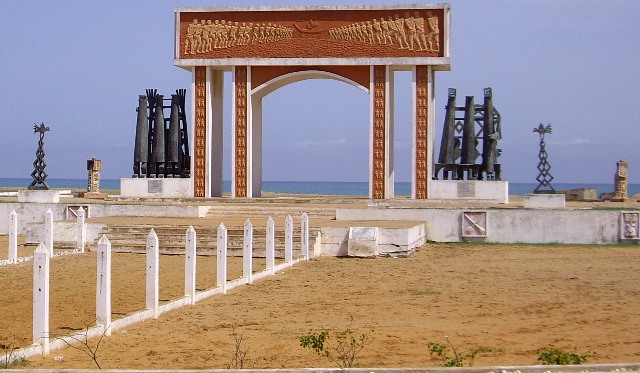
The slaves Road
It was in 1492 that Christopher Columbus discovered the Americas in his quest for the new world. The first slaves were Indians. Men not very resistant to major works. This is how the eyes naturally turned to the more massive and resistant Africans. It is thus in the 15th century that the strong Portuguese, French, English, Danish, Dutch settled on the Beninese coast to develop the triangular trade which is a slave trade carried out by means of exchanges between Europe, Africa and the Americas to ensure the distribution of black slaves to the colonies of the New World (American continent), to supply Europe with products from these colonies and to supply Africa with European and American products (mainly junk).
The Slave Route of Ouidah is the path that slaves from different parts of Africa took to gather in Ouidah before being deported to the New World. This road breaks down in six (6) stages in Ouidah that I will make you discover.
Step 1: Slave selection
The selection of slaves was done at the Place Chacha which takes its name from Félix Francisco de Souza said “Chacha” a large merchant of Ouidah of Portuguese-Brazilian origin that allowed King Guézo to free himself from prison and take the throne to his brother Adandozan who imprisoned him and sold his mother in protest of slavery. As a sign of recognition for this act, King Guézo appointed him First Vice King of the sub-region and gave him a parcel where the house is still installed. He married 41 women in respect to the lucky numbers and had 135 children.
Step 2: The tree of oblivion
Once marked, the slaves were chained and sent to the tree of oblivion, a tree planted in the 17th century by the King with the complicity of the Portuguese. The men had to go around this tree 9 times, and the women had to go around 7 times. The goal was to make them forget their origin, their tradition, their culture, their identity so that they no longer react as human beings but as animals.
The men made 9 laps and the women 7 laps because at the time the people thought that the men had 9 pairs of ribs and the women 7 pairs. Today science has shown that we have, as men and women, 12 pairs of ribs.
On the site, a tree has been replanted and at its side a status of a siren looking towards the sea, to the unknown destination.
Step 3: The last village
The last village of Zoungbodji is the one that the slaves crossed before being embarked. In this village, which at the time was a forest and a swampy area, the men were hungry to make them weak and thus reduce the rebellions. Occasionally they were given unsafe water. The most resistant survived and the others died.
When some rebelled, they were chained and put in their mouth, an akoko which is a piece of wood intended for cattle and which serves to guide it. The idea was to really reduce them to the animal state.
He remained in this village about 66 days and a half, the time necessary to have enough slaves.
Step 4: The cemetery
The box in which the slaves were stored before leaving was in the village of Zoungbodji, as was the cemetery, which was a false commune 10 meters deep and 6 meters wide.
Men and women were thrown indiscriminately, the sick, the weary, and the dead.
Step 5: The return shaft
The tree of return was intended to allow the spiritual return of the soul of slaves if they died in the path or on the spot to allow them to meet on the land of their ancestors and thus have the eternal rest.
The slaves, men as well as women, thus circled the tree three times.
This ritual was done in the presence of the “Egungun”, the ghosts and was impregnated in the voodoo tradition. The idea was to stay united and love.
Step 6: The Gate of No Return
The door of no return is the passage from which one could not return. Slaves after passing the slave route, this path where we find today many statues bearing messages and reminders of Beninese culture and the reigns of different kings, were exhausted. No one had the physical ability to retrace his steps.
Thus a monument was erected to symbolize this departure for an unknown land and an uncertain future.
We learn that Ouidah is the second gateway for slaves behind that of Pointe Noire (Congo) and before those of Goree (Senegal), Cape Coast (Ghana) and Zanzibar (Zanzibar Island).
This monument traces the highlights of the Route des Esclaves since the 6 stages are represented here on the facades.
Thus ends the journey of the slaves who will be chained for the travel